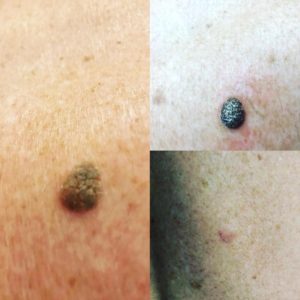Electrolysis Skin Blemish Removal
Electrolysis
Electrolysis can be used for the following:
– Facial Thread Veins – commonly found around the nose and on the cheeks
– Blood Spots – bright red vascular blemishes frequently found on the midriff, back or front
– Spider Naevi – a central dilated capillary with smaller capillaries like the legs of a spider
– Skin Tags – commonly found on the neck, underarm and areas of friction
– Milia – tiny white hard lumps containing keratin
Here at Mulberries Aesthetics & Beauty we only use Sterex professional products. Disposable probes are used to totally eliminate cross infection.
Advanced Electrolysis
Advanced Electrolysis can be used for the following:
– Thread Veins
– Milia
– Skin Tags / Fibro Epithelial Polyps
– Spider Naevi
– Blood Spots / Cherry Spots
– Broken Capillaries / Thread Veins
– Age Spots / Hyper Pigmentation
– Verrucas / Warts
– Sebaceous Cysts
– Mole Reduction
Up to 30 minutes – £75.00
Mole removal – £95 per mole

-
Electrolysis Methods Open Close
What are the different electrolysis methods?
Short wave diathermy or thermolysis uses an alternating current at a high frequency and low voltage. This causes the water molecules around the follicle to vibrate resulting in the production of heat, stopping the blood supply to the root, which weakens and eventually destroys the hair.
The galvanic DC (Direct Current) method causes a chemical reaction in the salt and water in the follicle. This reaction creates a chemical called sodium hydroxide or lye; the lye stops the nourishment to the cells that cause hair growth.
The Blend is the most recent method and combines Galvanic (DC) and Thermolysis (AC). This is the most effective method because the lye is more efficient at weakening the hair when heated. This is said to be the quickest and most comfortable method, especially good for curly or distorted hair follicles.
For successful and effective results, each individual hair requires repeated treatments. This is because each individual hair has its own growth cycles called Anagen, Catagen and Telogen. This is not unlike the ‘cycle of life’ with Anagen being the ‘alive’ and growing stage, Catagen the ‘collapsing’ stage where the hair collapses away from its source of food and nourishment (the dermal papilla) and the Telogen stage where the hair is ‘tired’ and dying and disconnected completely from its dermal papilla. Successful treatment for electrolysis (and incidentally also laser and IPL) has to target the hair in Anagen to achieve optimum results as it is the destruction of the dermal papilla that is required. Therefore results are not immediate and take a little time… but electrolysis does work and it is permanent!
-
Aftercare Open Close
Aftercare advice recommended for the 1st 48 hours following treatment will include:
- Avoid soap and perfumed products
- Avoid sunbathing
- Avoid picking or touching the area
- Avoid swimming, steam rooms and saunas
- Avoid further heat treatments to the immediate area
- Wash hands and apply aftercare product to the area using fresh cotton wool
- Avoid all temporary methods of hair removal except trimming
- Keep up with appointments to obtain desired results
-
FAQs Open Close
1.How do the results from laser compare to the results from electrolysis?
Both laser and electrolysis are very effective for removing superfluous hair. Although they both have their uses, electrolysis is the only proven permanent method of hair removal. Laser hair removal does have its limitations. The laser is attracted to the pigment within the hair; therefore white hair is difficult to treat. Hair growth as a result of a hormonal imbalance is also difficult to treat. The hair density can be reduced greatly but it is necessary to continue with electrolysis to obtain further, permanent results.
2.How long before a result can be seen?
Length of treatment depends on the hair growth problem that presents itself to the electrologist. The area worked upon must not be over treated and the client’s skin reactivity must be taken into account. Spacing between hairs and treatments will be carefully considered in a treatment plan by the electrologist as well as taking into account your requirements, needs and wishes. Electrologists meet a full spectrum of clients with various needs; from the mature client with fine vellus hair on the upper lip which may require a 10 minute fortnightly appointment and whose superfluous hair will be cleared within 6 months, to the polycystic ovary client who may require regular electrolysis for up to 2 years or more. Treatments are offered in the salon or clinic from 15 minutes up to 1-2 hours per appointment.
3.How many treatments do I need to permanently remove my unwanted hair?
Electrolysis is a proven permanent method of hair removal and is a progressive method of hair removal, meaning that it requires a course of treatments. Each individual hair is treated repeatedly as gently as possible so the hair becomes weaker and no tissue damage is caused. The cause of hair growth will influence the amount of treatments required. A treatment plan will be discussed with your electrologist during a full consultation, giving you some indication of the commitment required to obtain the desired results.
4.I’ve been having electrolysis for a few weeks and I feel that the hair growth is getting worse. Is this possible?
At the start of a course of electrolysis it is possible for the hair growth to ‘appear’ worse. This is because the hair growth must be left to grow for the electrologist to treat. Prior to electrolysis clients remove the existing hair by tweezing, waxing or threading. As this process is carried out frequently the full extent of the hair growth problem is not shown. When the electrologist asks the client to stop using temporary methods of hair removal, as this can interfere with the results, all the hair is allowed to grow causing the problem to appear worse.
See www.sterex.com for further information
Age Spots

Age spots (also known as liver spots) and hyper-pigmentation mostly occur on areas frequently exposed to the sun. They vary in size, shape and colour. They are caused by a build up of lipofuscin (a yellow pigmentation created by the aging of the collagen producing cells).
Whilst they are often referred to as ‘liver spots’ there is no physiological connection between the marks and the liver. Advanced Electrolysis provides a quick, safe and simple solution to the removal of age spots, leaving your skin looking clearer and younger.
Campbell de Morgan

Blood spots (also referred to as cherry spots) can be unsightly red blemishes located under the surface of the skin. Blood spots tend to be slightly raised and can vary in size, but are usually quite small. They are more common in men than women.
Electrolysis can effectively remove blood spots, leaving no trace whatsoever. The process is safe and very straightforward. Blood spots can be unsightly, and many people choose to have them treated, especially if they appear on the face or other visible areas of the body.
Milia

Milia can appear as a singular mark, or in a cluster. They are commonly found on the face around the eye and cheek area. They are slightly raised bumps that can vary in size but are usually quite small.
Milia are often associated with dehydrated or dry skin, which can lead to clogged pores and subsequently milia. They require professional treatment and electrolysis is a safe and effective way to remove them.
Moles

If you are unsure about any moles on your face or body, you should seek professional advice. Electrolysis can however effectively reduce the appearance of unsightly ‘normal’ moles, significantly reducing size and colour.
Whilst ‘normal’ moles are common, dependent on their size and location on the body they can be unsightly. Advanced Electrolysis is an effective way to reduce the size and appearance of moles, with impressive results. The size and appearance of unsightly moles can be visibly reduced and improved using Advanced Electrolysis techniques. However, for the patients safety, it is essential to ensure that the mole is a perfectly normal healthy mole before treatment can commence. Healthy moles are often pigmented growths or small blemishes on the skin that commonly appear in the first few decades of life in almost everyone. The average young adult has about 25 moles. Unusual or atypical moles can signify an increased risk of melanoma although malignant melanomas can arise from both existing moles or from healthy skin. The ABCDE rule helps recognise suspicious moles. A—Asymmetry, B—Blurred Borders (irregular, or jagged edge) C– Colour variation D– Diameter larger than 5mm (1/4 inch), E—Elevation (especially when uneven) E– Evolution (changes over time). Referral to a GP may be necessary prior to treatment.
Sebacious Cyst

A sebaceous cyst appears as a smooth, raised, skin coloured dome on the surface of the skin. They can vary in size and can appear with an open or closed top. They are more common on hairier areas of the body.
Sebaceous cysts are prone to infection and therefore best treated. Providing they are not too large, electrolysis can be an effective treatment solution. More than one treatment is usually required.
Seboric Keratosis

Seborrheic keratosis is a benign skin growth that manifests itself as flat or slightly elevated lesions that are brown or black in colour. They can occasionally resemble a wart and tend to appear with age.
The marks can resemble melanoma skin cancer, although there is no connection to melanoma. They can also appear to look like liver spots. Seborrheic Keratosis can be successfully and safely treated using advanced electrolysis.
Skin Tags

Skin tags are believed to form due to skin rubbing against skin, so are often found in creased areas of the face or body such as eyelids and neck. They are more commonly found on women than man, but can be effectively treated with electrolysis.
Skin tags are also known as Fibro epithelial polyps or papillomas. They can be completely removed with advanced electrolysis treatment, leaving no marks or evidence on the skin whatsoever.
Spider Naevi

Spider navei consist of a central red spot, surrounded by extended lines looking similar to that of a spider’s web. They can be successfully treated with electrolysis leaving no remaining mark on the skin.
Spide navei can be made to appear worse if the area of the skin is put under stress or pressure (for example, during pregnancy). Extreme heat can also affect their appearance. Electrolysis provides a safe, simple and effective solution.
Telangiectasia

Telangiectasia are small dilated blood vessels that can develop anywhere on the body, but are most commonly found on the face. They are located close to the surface of the skin and can be easily treated with electrolysis.
The marks can also appear on the legs, but this is often a sign of hidden varicose veins, which must be checked by a medical professional. They can measure between 0.5 and 1.0mm in diameter and appear in groups or clusters. Electrolysis can safely remove Telangiectasia.
Warts

Most often found on the hands or feet, but can appear anywhere on the body, warts are contagious growths caused by a viral infection of the skin cells. They are often likened to resembling a cauliflower or hard blister.
Advanced Electrolysis can be used to remove warts, leaving little or no evidence of their existence. Due to their highly contagious nature and their unsightly appearance, many people opt to have warts professionally removed.
